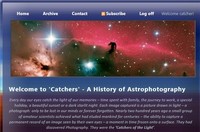
The 'Ages of Astrophotography' - is the sequel to the 'Catchers of the Light'. It tells the History of Astrophotography through 'Past & Present' Images.
   Come visit 'Catcher' our colourful and vibrant Blog. Learn more about Astrophotography, its Historyand the pioneers who made it all possible.
Recent Blogs have included a piece on William Parsons, 3rd Earl of Rosse and how his story is that of a Real 'Downton Abbey', the Story of God's astronomer - Father Pietro Angelo Secchi, Ten Famous Astronomical Photographs and the Leprechaun's Guide to Digital Photography - the true story of how the CCD camera was invented. |
|
  The 'Catchers of the Light' eBooks on the History of Astrophotography can NOW be read on Windows PCs & Androids, Apple Macs and iPads. Our Customers can use ANY or ALL of the following THREE different formats to read the 'Catchers of the Light':
The free unencrypted introduction to the 'Catchers of the Light' - History of Astrophotography can also be read on any PC, Mac iPad or Kindle with pdf reader software installed. When purchasing the complete 'Catchers of the Light', customers will be provided with Access/Download Instructions for ALL of the above THREE versions of the eBook. For further information on our eBooks and the 'anti-piracy' software used to protect them, see Our eBooks page.
|
|
|

Dr. Stefan Hughes began his career as a professional astronomer, gaining a 1st Class Honours degree in Astronomy from the University of Leicester in 1974 and his PhD four years later on the 'Resonance Orbits of Artificial Satellites due to Lunisolar Perturbations', which was published as a series of papers in the Proceedings of the Royal Society of London. After graduating he became a Research fellow in Astronomy, followed by a spell as a lecturer in Applied Mathematics at Queen Mary College, London. Then came a ten year long career as an IT Consultant. In 'mid life' he spent several years retraining as a Genealogist, Record Agent and Architectural Historian, which he practiced for a number of years before moving to the Mediterranean island of Cyprus, where for the past ten years he has been imaging the heavens, as well as researching and writing the 'Catchers of the Light' - A History of Astrophotography.


